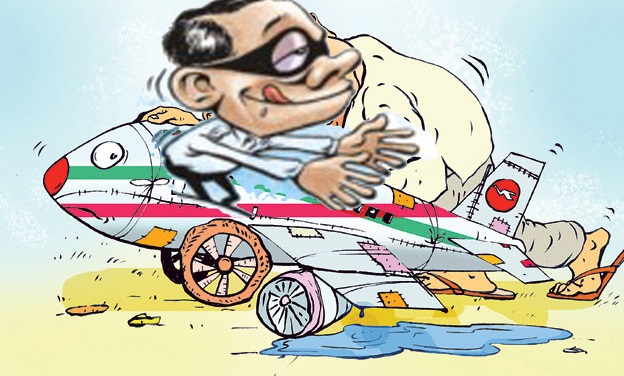
Biman’s losses continue as few choose to fly

For Biman Bangladesh Airlines, it was a highly unusual flight, almost eerie. On 9 October this year, Biman flew a 162-seat aircraft from Dhaka to Kuala Lumpur carrying only one passenger.
The national carrier earned Tk41,000 selling that one ticket, while it had to spend Tk26 lakh for operating the flight. However, its earnings from the return flight were Tk35 lakh as the passenger load increased to 80%.
As a result, Biman had to incur a loss of approximately Tk17 lakh for the both-way flight operation. The state-owned airline is currently operating two weekly flights on the Dhaka-Kuala Lumpur route.
But it is an unusual time Biman is in. This is only an extreme example of Biman's loss-making operations and Biman has continued to bleed money even after resuming flight operations in July this year after a three-month break.
Even though the Civil Aviation Authority of Bangladesh (Caab) reopened the country's airports on 1 June for domestic flights and on 16 June for international ones, Biman resumed full-fledged operation the following month.
Flight operations had remained suspended since 26 March due to travel restrictions induced by the novel coronavirus pandemic.
In the three months after the resumption of flights – from July to September this year, Biman incurred a pre-tax loss of Tk125 crore, while the company's losses stood at Tk14 crore in the previous 12 months, according to official sources.
Biman actually made a profit of Tk483 crore during the July-January period of the last fiscal year. However, the Tk14 crore loss counted in the financial year was due to the massive loss the company incurred during the flight suspension period – from April to June.
The losses made by Biman during the flight suspension period was less compared to the post-flight resumption period, as the carrier operated many chartered flights after the outbreak of the coronavirus, which were profitable.
Running regular flight operations is now unprofitable for Biman because the average passenger load factor has come down to 30-40% compared to 80% in normal times.
It is evident that the national carrier is struggling to stay afloat, but it seems the worst is yet to come as the stimulus support of Tk1,000 crore given to Biman in April is running out fast while passenger traffic is still far from the pre-pandemic level.
The stimulus support is being used for meeting the monthly fixed cost of Biman. The company's monthly fixed cost is around Tk350 crore, which include Tk150 crore installments for bank loans, Tk98 crore for lease installment, Tk35 crore for maintenance of aircraft and Tk50 crore for regular salaries of staff members.
On top of this, there is now the additional strain of the installments against the stimulus loan. Moreover, the cost of flight operation has increased amid low traffics and a rise in aviation and landing charges in different countries amid the pandemic.
Consequently, the huge losses have increased Biman's liabilities to the national oil company PetroBangla and Caab for failing to pay regular fuel prices and aviation charges.
Now the Biman authorities are planning on seeking a second round of fund support from the government to stay afloat.
In the meantime, Biman Bangladesh Airlines has undertaken extensive self-help measures to reduce operational costs. This includes cutting salaries and flight frequency, rescheduling loan installments and lease installments, and reducing all non-critical expenses.
Attributing Biman's huge losses to under-load flight operations, its Managing Director Md Mokabbir Hossain said, "At present, Biman has flight operations in 12 destinations, down from 18 in the pre-pandemic period. It has been operating less than 25% of its flights – 31 out of 136 – since resuming operation in June."
He gave an example of low passenger traffic saying a flight from Dhaka to Singapore on 8 October carried only 4 passengers and then returned to Dhaka with 17 passengers.
Biman currently has one weekly flight to Singapore.
"Even though flight operations have resumed, the number of new flyers is very low. Most of the flyers are stranded expatriate workers," the Biman managing director explained.
For instance, he said, seven flights were being operated on the Dhaka-Abu Dhabi route at the beginning of the resumption of flight operation. Later, the flight frequency was gradually reduced to three as the load factor came down to 40% after all stranded labourers completed their journeys, he added.
On the other hand, a 260-seat aircraft currently flies with around 90 passengers on the Dhaka-Doha-Dhaka route, Mokabbir continued.
On a pessimistic note, he said there is little hope of an increase in the number of fresh flyers in near future as the fear of the second wave of Covid-19 has already gripped the world.
Amid this low passe
Editor & Publisher: S. M. Mesbah Uddin
Published by the Editor from House-45,
Road-3, Section-12, Pallabi, Mirpur
Dhaka-1216, Bangladesh
Call: +01713180024 & 0167 538 3357
News & Commercial Office :
Phone: 096 9612 7234 & 096 1175 5298
e-mail: financialpostbd@gmail.com
HAC & Marketing (Advertisement)
Call: 01616 521 297
e-mail: tdfpad@gmail.com